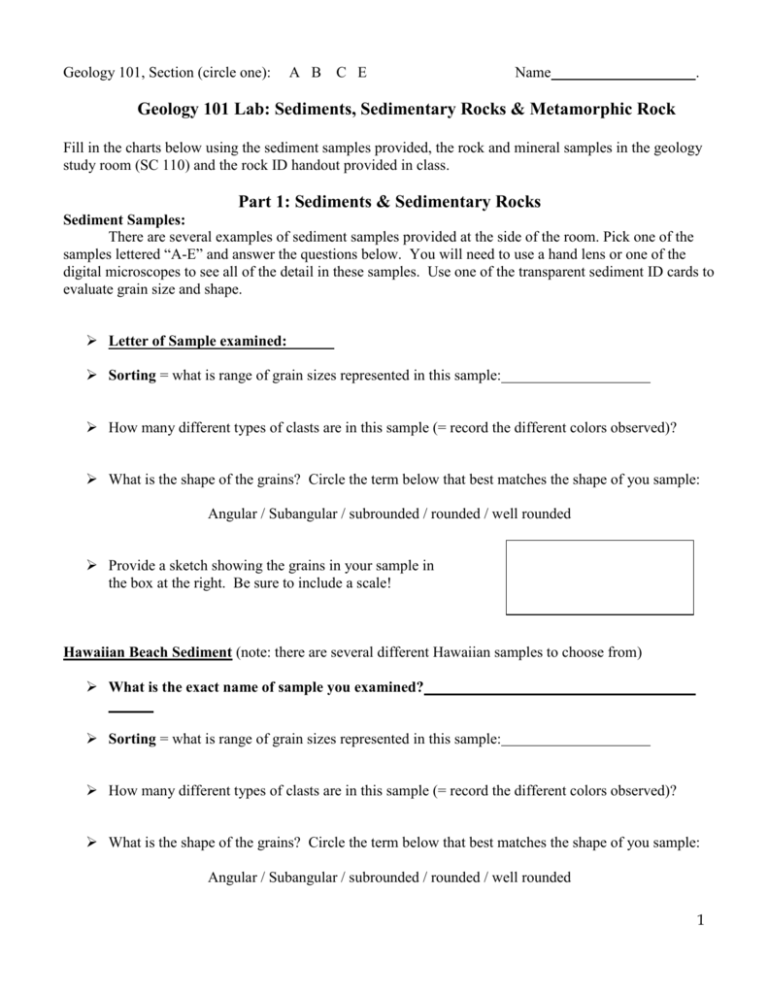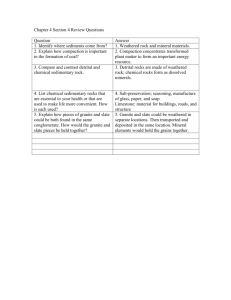Geology 101 Lab: Sediments, Sedimentary Rocks & Metamorphic
advertisement

Geology 101, Section (circle one): A B C E Name . Geology 101 Lab: Sediments, Sedimentary Rocks & Metamorphic Rock Fill in the charts below using the sediment samples provided, the rock and mineral samples in the geology study room (SC 110) and the rock ID handout provided in class. Part 1: Sediments & Sedimentary Rocks Sediment Samples: There are several examples of sediment samples provided at the side of the room. Pick one of the samples lettered “A-E” and answer the questions below. You will need to use a hand lens or one of the digital microscopes to see all of the detail in these samples. Use one of the transparent sediment ID cards to evaluate grain size and shape. Letter of Sample examined: Sorting = what is range of grain sizes represented in this sample: How many different types of clasts are in this sample (= record the different colors observed)? What is the shape of the grains? Circle the term below that best matches the shape of you sample: Angular / Subangular / subrounded / rounded / well rounded Provide a sketch showing the grains in your sample in the box at the right. Be sure to include a scale! Hawaiian Beach Sediment (note: there are several different Hawaiian samples to choose from) What is the exact name of sample you examined? Sorting = what is range of grain sizes represented in this sample: How many different types of clasts are in this sample (= record the different colors observed)? What is the shape of the grains? Circle the term below that best matches the shape of you sample: Angular / Subangular / subrounded / rounded / well rounded 1 Hawaiian Beach sediment cont. Provide a sketch showing the grains in your sample in the box at the right. Be sure to include a scale! Considering the information that we’ve discussed about Hawaii, what is the most likely rock for the the black sediment grains (clasts) to have come from? Common Mineral found in Sedimentary Rocks: Two common minerals commonly found in sedimentary rocks are quartz and calcite. Examine the sample of these minerals in SC 110 and on display in SC 111 the mineral ID handout and fill in the chart below. Calcite Quartz What is the hardness? Color(s) Directions of Cleavage Acid Reaction Hints to help ID Sedimentary Rocks: Examine the named rock samples in room 110 and answer the questions below: What is the difference between a Breccia and a Conglomerate? What test(s) can you conduct that will help you determine the different amount a fine-grained limestone, a mudstone, and chert? 2 Common Sedimentary Rocks/ Rock ID Note: For texture/mineral, if the composition was clastic, state the average grain size (= mud, sand or gravel) and the grain texture (round or angular). If the composition of the rock is chemical write the name of the most common mineral/rock composition. Sample # Composition: Detrital (= clastic) or Chemical SQ-13 SQ-14 SQ-18 SQ-22 SQ-23 SQ-28 SQ-34 Rock 3 Describe: Texture (for detrital rocks) or Chemical Composition (for chemical rocks) Detrital or Chemical Detrital or Chemical Detrital or Chemical Detrital or Chemical Detrital or Chemical Detrital or Chemical Detrital or Chemical Detrital or Chemical Rock Name Suggest a Possible Environment of Deposition (name only the gray part) Part 2: Metamorphic Rocks Hints to help ID Metamorphic Rocks: Suggest at least one way you can distinguish between shale (= a layered mudstone) and slate: List two ways you can distinguish between Quartzite and Marble besides color & banding. 3 Common Metamorphic Rocks/ Rock ID Examine the rocks listed below and fill in the following table using the Metamorphic Rock ID chart in your rock and mineral handout. If you have difficulty determining the “protolith” or “parent rock”, then check the information in Chapter 7 of your text. Rock Foliated? Mineral Composition or Possible Protolith Rock Name (y/n) other features (aka Parent Rock) SQ-11 SQ-12 SQ-19 SQ-39 Sample Rock-6 Sample Rock-7 Sample Rock-8 Rock ID checked on: by . Summary Question: Arrange the foliated metamorphic rock in order from lowest to highest metamorphic grade: Lowest = Highest = Mystery Rocks (may be any type of rock or mineral) #1 #2 #3 When you have completed this portion of the lab, you should ask for the SQ Rock ID Sheet and take the opportunity to study the remaining self quiz samples. 4





